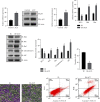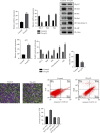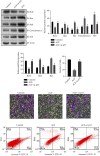The Activation of the Tumor Suppressor Protein p53 by Acriflavine Leads to Mitochondrial Dysfunction and Improves the Radiosensitivity of Colon Cancer Cells
- PMID: 35935580
- PMCID: PMC9355786
- DOI: 10.1155/2022/1328542
The Activation of the Tumor Suppressor Protein p53 by Acriflavine Leads to Mitochondrial Dysfunction and Improves the Radiosensitivity of Colon Cancer Cells
Abstract
Colon cancer ranks third worldwide, and it has a growing incidence with urbanization and industrialization. Drug resistance in colon cancer is gradually affecting the treatment. This study focused on the mechanisms by which acriflavine (ACF) enhances the radiosensitivity of colon cancer cells. First, the expression and activation levels of tumor suppressor protein p53 were shown high in normal cells and tissues in its detection, which suggests that p53 is likely to be a key factor in colon cancer. Then, the expression of p53 ended up increasing in ACF group after SW620 cells were cultured with ACF. In addition, ACF group had some other changes. The expression of mitochondrial related antiapoptotic protein Bcl-2 increased, while the expression of proapoptotic protein Bax, Bad, cytopigment C, and apoptotic inducer AIF decreased. At the same time, the ability of apoptosis was enhanced, and the ability of proliferation and invasion was decreased. This suggests that ACF can promote p53 expression and affect mitochondrial function and the radiosensitivity of SW620. The luciferase reporting experiment showed that there was a binding site between ACF and p53. Besides, when IR treatment was applied to SW620 with high p53 expression, there was an increase in the expression of Bcl-2 in SW620 and decrease in Bax, Bad, and cytopigment C in AIF. Meanwhile, the cell apoptosis became stronger, and the proliferation and invasion became weaker. The experimental results were similar to those of SW620 cells cultured with ACF, suggesting that p53 is an intermediate factor in the regulation of SW620 by ACF. Finally, in this study, cells were cultured with ACF, and p53 was knocked down at the same time. The experimental results showed that after p53 was knocked down. ACF's ability to regulate SW620 is partially removed. This confirms the view that ACF regulates SW620 cells by regulating p53. In summary, this study found the mechanism by which ACF causes mitochondrial dysfunction and improves the radiosensitivity of colon cancer cells by activating the tumor suppressor protein p53, which may contribute to solving the drug resistance in colon cancer.
Copyright © 2022 Caizhao Lin et al.
Conflict of interest statement
The authors declare that they have no conflicts of interest.
Figures




Similar articles
-
Acriflavine enhances radiosensitivity of colon cancer cells through endoplasmic reticulum stress-mediated apoptosis.Int J Biochem Cell Biol. 2012 Aug;44(8):1214-22. doi: 10.1016/j.biocel.2012.04.022. Epub 2012 May 4. Int J Biochem Cell Biol. 2012. PMID: 22564437
-
Modification of gene products involved in resistance to apoptosis in metastatic colon cancer cells: roles of Fas, Apaf-1, NFkappaB, IAPs, Smac/DIABLO, and AIF.J Surg Res. 2007 Sep;142(1):184-94. doi: 10.1016/j.jss.2006.12.551. Epub 2007 Jul 2. J Surg Res. 2007. PMID: 17603079
-
Induction of p53 contributes to apoptosis of HCT-116 human colon cancer cells induced by the dietary compound fisetin.Am J Physiol Gastrointest Liver Physiol. 2009 May;296(5):G1060-8. doi: 10.1152/ajpgi.90490.2008. Epub 2009 Mar 5. Am J Physiol Gastrointest Liver Physiol. 2009. PMID: 19264955
-
Targeting p53 to mitochondria for cancer therapy.Cell Cycle. 2008 Jul 1;7(13):1949-55. doi: 10.4161/cc.7.13.6222. Cell Cycle. 2008. PMID: 18642442 Review.
-
Acriflavine, an Acridine Derivative for Biomedical Application: Current State of the Art.J Med Chem. 2022 Sep 8;65(17):11415-11432. doi: 10.1021/acs.jmedchem.2c00573. Epub 2022 Aug 26. J Med Chem. 2022. PMID: 36018000 Free PMC article. Review.
Cited by
-
p53 in colorectal cancer: from a master player to a privileged therapy target.J Transl Med. 2025 Jun 19;23(1):684. doi: 10.1186/s12967-025-06566-4. J Transl Med. 2025. PMID: 40537809 Free PMC article. Review.
References
MeSH terms
Substances
LinkOut - more resources
Full Text Sources
Research Materials
Miscellaneous

